Plantlike Protists - Algae
The phyla grouped here as eukaryotic algae consist mainly of photosynthetic
organisms, although some phyla include heterotrophic or mixotrophic members.
The term alga refers to relatively simple aquatic organisms that are photoautotrophs.
Except for the prokaryotic cyanobacteria (formerly called blue-green algae),
the organisms generically called algae are eukaryotes that most systematists
classified in kingdom Protista in the five-kingdom system.
Algae are extremely important ecologically, accounting for about half
the photosynthetic production of organic material on a global scale. As
freshwater and marine phytoplankton and intertidal seaweeds, algae are
the bases of aquatic food webs, supporting an enormous abundance and diversity
of animals.
All algae have chlorophyll a, the same “primary” pigment found in plants.
But algae differ considerably in their accessory pigments, pigments that
trap wavelengths of light to which chlorophyll a is not sensitive. These
pigments include other forms of chlorophyll (greenish), carotenoids (yellow-orange),
xanthophylls (brownish), and phycobilins (red and blue varieties). The
mixture of pigments in the chloroplasts lends characteristic colors to
related algae. Many of the scientific and common names of algal phyla are
based on these colors (the Chlorophyta, or green algae, for example). Study
of these pigment mixes has helped establish taxonomic affinities among
the algae. Additional clues have come from chloroplast structure; the chemistry
of cell walls (a few algal phyla lack walls); the number, type, and position
of flagella; and the form of food stored by the cells.
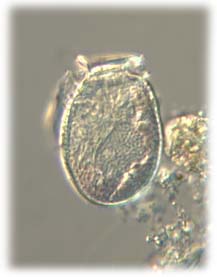 |
Dinoflagellata (Dinoflagellates)
Dinoflagellates are abundant components of the vast aquatic pastures
of phytoplankton, microscopic algae floating near the surface of the sea
that provide the foundation of most marine food chains.
Dinoflagellate blooms, episodes of explosive population growth, cause
the red tides that occur occasionally in warm coastal waters. These blooms
are brownish-red because of predominant xanthophylls in the chloroplasts.
When suspension-feeding shellfish such as oysters feed on these blooms,
they concentrate the algae along with toxic compounds released by the dinoflagellate
cells. These toxins are extremely dangerous to humans, who collect and
eat the invertebrates. As a consequence, collecting shellfish during red
tides is often regulated to prevent the widespread occurrence of “paralytic
shellfish poisoning.” |
| Bacillariophyta (Diatoms)
The members of the phylum Bacillariophyta, or diatoms, are yellow or
brown in color. They are closely related to two other algal phyla with
brown plastids, the golden algae (Chrysophyta) and brown algae (Phaeophyta).
Diatom cells have unique glasslike walls consisting of hydrated silica
embedded in an organic matrix. Each wall is in two parts that overlap like
a shoe box and lid. Many diaotoms are capable of a gliding movement caused
by chemicals secreted out of slits in their cell walls. |
 |
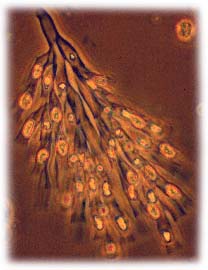 |
Chrysophyta (Golden Algae)
Golden algae are named for their color, which results from yellow and
brown carotenoid and xanthophylls accessory pigments. Their cells are typically
biflagellated, with both flagella attached near one end of the cell. Golden
algae live among freshwater plankton. Most species are colonial. In ponds
and lakes that freeze in winter or dry up in summer, golden algae survive
by forming resistant cysts, from which active cells emerge when conditions
are favorable. Microfossils resembling the ruptured cysts of chrysophytes
and other algae are among the acritarchs found in Precambrian rocks. |
| Phaeophyta (Brown Algae)
The largest and most complex algae are members of the phylum Phaeophyta,
or brown algae. All are multicellular and most are marine, including the
largest seaweeds. Brown algae are especially common along temperate coasts,
where the water is cool. They owe their characteristic brown or olive color
to accessory pigments in the chloroplasts. The chloroplast structure and
pigment composition of brown algae are homologous to the photosynthetic
equipment of golden algae and diatoms. |
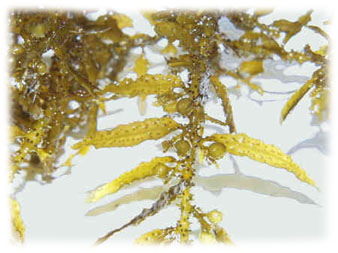 |
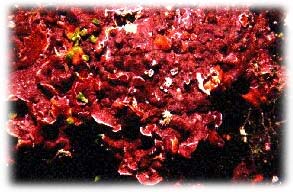 |
Rhodophyta (Red Algae)
The majority of members of Rhodophyta, or red algae, live in the ocean,
but there are also some freshwater and soil species. Rhodophytes are commonly
reddish because of an accessory pigment called phycoerythrin. It belongs
to a family of pigments known was phycobilins, found only in red algae
and cyanobacteria.
Red algae are most abundant in the warm coastal waters of the tropics.
The phycobilins and other accessory pigments allow some species to absorb
filtered wavelengths (blues and greens) in deep water. A species of red
alga has recently been discovered living near the Bahamas at a depth of
more than 260 m. |
| Chlorophyta (Green algae)
This phylum is named for its members’ grass-green chloroplasts, which
are much like those of plants in ultrastructure and pigment composition.
In fact, most botanists believe that the ancestors of the plant kingdom
were related to a group of green algae.
More than 7000 species of green algae have been identified. Most live
in fresh water, but there are also many marine species. Various species
of unicellular green algae live as plankton, inhabit damp soil or snow,
or occupy the cells or body cavities of protozoa and invertebrates as photosynthetic
symbionts that contribute to the food supply of the hosts. Chlorophytes
are also among the algae that live symbiotically with fungi in the mutualistic
collectives known as lichens. |
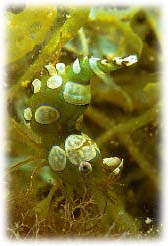 |





